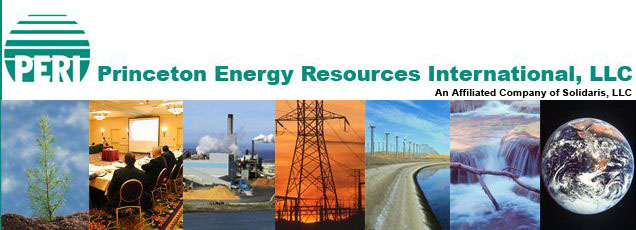

Technical Support Services, USDOE Office of Clean Coal
Under this $14 million, task order contract, PERI is providing a variety of technical support to the U.S. Department of Energy's (DOE) Office of the Deputy Assistant Secretary (DAS) for Clean Coal. The objective of this office is to develop and demonstrate, in partnership with the industry, advanced technologies for power generation and for production of ultra-clean transportation fuel from coal, natural gas, opportunity fuels, and other feed stocks while increasing efficiency, eliminating emission of harmful pollutants, and reducing generation and/or production costs. Further, this office collaborates with international partners on projects for hydrogen production and reducing environmental pollutants particularly with respect to greenhouse gas emissions.
PERI's support to date has included:
Risk Analysis for Energy R&D Programs
For the U.S. Department of Energy, PERI developed a probabilistic R&D risk assessment methodology to quantitatively evaluate risk versus benefits for various wind turbine technology development pathways. PERI then adapted the methodology for broader application across many DOE energy R&D programs and is currently assisting DOE in preparation of step-by-step procedures for a best-practices guide for R&D Managers, called "Risk Analysis for Energy R&D Programs - A Practical Best-Practice Guide." Risk is a central characteristic of research and technology development programs. Attempting to do what no one has ever done before will inevitably sometimes end in failure, just as it will sometimes lead to extraordinary success. The challenge is how to maximize the likelihood of success while minimizing the costs of failure. This Guide provides quantitative methods for risk analysis and management tools to meet that challenge.
Technical and Engineering Support
PERI personnel managed an $8.5 million, task order contract with Department of Energy's Morgantown Energy Technology Center (METC). Under this contract, PERI personnel successfully managed the completion of task assignments ranging from $17,000 to over $800,000 covering technical, engineering, economic, and market assessments and evaluations for a wide range of technologies including Integrated Gasification Combined Cycle (IGCC), Fluidized Bed Combustion (FBC), Natural Gas Processing and upgrading, Waste to Energy Conversion, environmental technologies for applications at a nuclear waste site, and new char and coke making technologies. Successful management of this task order contract by PERI personnel led to a $3 million, sole-source follow-up contract.
Planning, Organizing, and Implementing Orientation Visits and Technical Symposiums for USTDA
Since 2002, PERI has been planning, organizing, and implementing orientation visits (OVs) and technical symposiums (TSs) on behalf of the U.S. Trade and Development Agency (USTDA). The objective of these OVs and TSs is to introduce private and public sector executive from developing and middle-income countries to U.S. technologies, equipment, and know how and of fer the U.S. industry a one stop shop to learn about up coming projects and services needed in those countries. For each OV and/or TS, PERI prepares an 8 to 10 day program including meetings with U.S. industry and government representatives, plant tours, business briefings, financing workshops, technical workshops, and technical exhibits. PERI also develops the technical content of the program and prepares the necessary background information on the U.S. industry for the invited foreign delegates and on the project opportunities in the host country for the U.S. participants. Furthermore, PERI provides all the needed logistic support including international and domestic air travel, ground transportation, translation and interpretation, conference site venue, etc. Click here to see Briefing Books and Reports prepared for USTDA events coordinated by PERI.
fer the U.S. industry a one stop shop to learn about up coming projects and services needed in those countries. For each OV and/or TS, PERI prepares an 8 to 10 day program including meetings with U.S. industry and government representatives, plant tours, business briefings, financing workshops, technical workshops, and technical exhibits. PERI also develops the technical content of the program and prepares the necessary background information on the U.S. industry for the invited foreign delegates and on the project opportunities in the host country for the U.S. participants. Furthermore, PERI provides all the needed logistic support including international and domestic air travel, ground transportation, translation and interpretation, conference site venue, etc. Click here to see Briefing Books and Reports prepared for USTDA events coordinated by PERI.
Energy Generation and R&D Project Evaluation and Selection
For Xcel Energy, PERI prepared a solicitation document requesting proposals for energy research and development as well as energy generation projects. In response to this solicitation over 260 proposals were received ranging from laboratory scale research for development of new catalysts to large scale power generation projects covering a wide range of technologies including thermal and bio-gasification of biomass and coal, wind energy, solar energy, gas separation, and gas clean-up. PERI evaluated these proposals consistently using a pre-determined and approved ranking methodology that incorporated a probabilistic risk analysis. PERI recommended projects were awarded grants by Xcel Energy. The process was transparent and public and PERI defended its recommendations at public forums.
Survey of Installation and O&M Costs for Wind Energy Projects
For the National Rural Electric Cooperative Association, PERI provided 10 in-depth case studies of installation and O&M costs for wind projects consisting of turbines rated at 600 kW and above, with total project sizes in the 2-10 MW range. PERI identified financial incentives for wind technologies applicable to rural electric cooperatives. PERI interpreted the limitations and value of the incentives as they apply to electric cooperatives. In addition, PERI explored the use of project cash flows to demonstrate the financial impact of various incentives.
Climate Models Analysis
For the Office of Policy, Climate Policy and Programs, U.S. Environmental Protection Agency, PERI was commissioned to conduct a comparative assessment of major economic models to characterize technology diffusion processes, assumptions, and modes of operation. Based on an extensive review of the technology evolution and diffusion literature, the project recommended ways to implement improved characterization and processing of technology variables within the economic and policy modeling environment. In addition, PERI provided support for Technical Assistance activities of the U.S. Initiative on Joint Implementation (IJI) Secretariat through the EPA/OP's Climate Policy and Program Division. Specifically, PERI evaluated project proposals, considering criteria such as greenhouse gas baseline emissions, viability of greenhouse gas reduction or sequestration estimates, and identification of associated non-greenhouse gas environmental impacts/benefits.
Utility Analysis Support
PERI is assisting the National Renewable Energy Laboratory (NREL) in its analysis of opportunities for renewable energy systems in the electric power sector. Topics under this contract are varied, but focus primarily on technology status and prospects, market segmentation and evolution. Results have been used in a range of forums. For instance, the technology data have been used in working with Energy Information Administration (EIA) and National Energy Modeling System (NEMS) modeling for the Annual Energy Outlook, and in the estimation of program benefits for a variety of program planning needs. Under this contract, PERI managed a major technology assessment co-sponsored by DOE and the Electric Power Research Institute (EPRI). This multi-program effort resulted in the joint report Renewable Energy Technology Characterizations (EPRI TR-109496), published in December 1997. This document is an authoritative examination of the current status and future potential for 12 different configurations of biomass, geothermal, photovoltaic, solar thermal, and wind technologies. For this project, PERI led a team of analysts that defined the framework and content of the assessment, provided technical guidance and review for authors' submissions, and facilitated the participants' arrival at a consensus on the final content of the report. PERI has also developed a variety of methodologies and analytical frameworks for the quantification of benefits from installing renewable energy technologies. PERI led a recent activity to develop a Renewable Energy Technologies Emerging Market (RETEM) Model. This analysis framework encompasses results from the NEMS and two special market models that PERI has developed - one for Green Power and one for Distributed Green markets. Both of the new models are regional and therefore both reflect the effects of key technology performance and resource characteristics. They also reflect regional socioeconomic, political, and regulatory factors. These models have been peer-reviewed through an Internet-based interactive Delphi process.
Management and Administrative Support Services for the U. S. Department of Energy's Office of Utility Technologies
PERI provided management and administrative support services to the Office of the Deputy Assistant Secretary (DAS) and to various program offices within the DAS Office for Utility Technologies. Specific program areas of support include Geothermal, Hydropower, Wind Energy, Solar Thermal, Photovoltaic, Biomass Power, Hydrogen, Superconductivity, and Electric Energy Storage. Work under this contract included the evaluation and analysis of technical, regulatory, and economic issues impacting conservation and renewable energy in electric power generation. Additional support activities focused on resource and technology characterization; program planning, analysis and review; renewable activities at the 1996 Olympics; and the integration of Climate Challenge program. Key efforts included economic analysis, database development, development of an options workbook for utility actions to reduce greenhouse gas emissions, technology fact-sheets, and modeling of emissions reductions due to various market development scenarios in support of DOE's Quality Metrics budget priority analysis. Specific skills utilized under above mentioned support activities include staff with direct experience in energy engineering, environmental analysis, financial analysis, policy analysis, program planning and evaluation support, outreach, literature review, meeting/conference support, and document review and preparation.
Stakeholder Perspectives on Global Warming
PERI worked with the EPA Climate Wise Program and a public, nonprofit organization called the Climate Neutral Network (CNN) to conduct survey and market research in support of CNN efforts to design an international brand and business approach. This work included survey design, research agenda formation, and facilitation of a series of focus groups with statistically profiled customer categories. Focus group findings were used to help define CNN projects and programs, and to help develop an international CNN "Brand". Other participants in the CNN process include Nike, BP, Ben and Jerry's, Chevron, Interface, and Business for Social Responsibility. As a direct follow-on to the CNN focus groups, PERI is working with EPA to review public understanding of the global warming issue and to capture information pertinent to the redevelopment of the Agency's global warming Web site. This work includes development and management of four targeted, in-depth focus groups involving a review of the topic (global warming), information management preferences, and recommendations for web site content and functionality. EPA is currently using the focus group findings in the revision of its Global Warming Web site.
Development of Financial Analysis Tool for Electric Energy Projects (FATE2-P)
PERI developed a spreadsheet-based, interactive power plant project finance computer model, FATE2-P (Financial Analysis Tool for Electric Energy Projects) for the National Renewable Energy Laboratory. The model may be used with either renewable energy technology or conventional fuel projects. This model analyzes projects using a choice of several different approaches: (1) a conventional utility's revenue requirements approach; (2) an Independent Power Producer's Discounted Cash Flow-Return On Investment method; (3) ownership/financing by a tax-free municipal utility; and (4) a Generating Company ("GenCo") approach using balance-sheet finance. Using FATE2-P, PERI has modeled technical improvements (e.g., improved airfoils on a wind turbine and faster wind speeds) and the effects on project COE's. PERI has modeled more favorable tax treatment (e.g., accelerated depreciation, tax credits) and those effects on project COE's. For example, PERI assisted DOE in modeling and evaluating production tax credits (per Kwh output) vs. investment tax credits (per dollar of capital cost) for wind energy, which led to the adoption of the Section 45 production tax credits with the Energy Policy Act. Another recent task illustrative of model refinement activities, PERI staff upgraded the
FATE2-P cash flow model to analyze tax equity issues.
| Back to Practice Areas |

